SACRED HINDU TEXTS
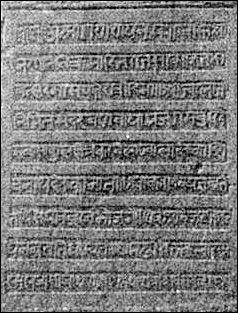
Sanskrit Atashgah Siva-inscription Hinduism have many sacred documents but no single sacred text such as the Bible. "The result," writes historian Daniel Boorstin, is "a wonderfully varied and constantly enriching Hindu jingle-jangle of truths, but no one path to The Truth." Hindu texts are so closely associated with Sanskrit that all translations are regarded as profanation.
There are six primary sacred texts of Hinduism, each associated with a stage of Hinduism’s evolution. They are: 1) the “Verdic Verses” , written in Sanskrit between 1500 to 900 B.C.; 2) the “Upanishads” , written 800 and 600 B.C.; 3) the “Laws of Manu”, written around 250 B.C.; and 4) “Ramayana” and 5) the “Mahabharata”, written sometime between 200 B.C. and A.D. 200 when Hinduism was popularized for the masses; and 6) the Agamas.
The Vedas and their supplements (books based on the Vedas) are regarded as the main Hindu texts. Veda is a Sanskrit word meaning 'knowledge'. These scriptures do not mention the word 'Hindu' but many scriptures discuss dharma, which can be rendered as 'code of conduct', 'law', or 'duty' Hindus believe that the Vedas texts were received by scholars direct from God and passed on to the next generations by word of mouth. [Source: BBC]
The Vedas are a collection of ancient Sanskrit hymns, as the revealed source of religious belief through the visions of ancient rishis, or seers. The Upanishads are later scriptures (after 1000 B.C.). The Vedas and Upanishads are the most widely accepted sacred texts in India. A large number of later scriptures are also accepted as scripture by various groups. Among the most popular of these later scriptures is the Bhagavad-Gita from the “Mahabharata”.
Hindu cosmology was explained in the Vedas. The Upanishads provided a theoretical basis for this cosmology. The “Brahmanas” , a supplement to the Vedas, offers detailed instructions for rituals and explanations of the duties of priests. It gave form to abstract principals offered up in the earlier texts. Sutras are additional supplements that explain laws and ceremonies.
Hindu scriptures were composed, memorized and transmitted verbally, from generation to generation, for many centuries before they were written down. Over many centuries, sages refined the teachings and expanded the Shruti and Smriti, as well as developed Shastras with epistemological and metaphysical theories of six classical schools of Hinduism. [Source: Wikipedia]
See Separate Articles UPANISHADS factsanddetails.com ; HINDU LITERATURE: RAMAYANA, MAHABHARTA AND BHAGAVAD GITA factsanddetails.com ; MAHABHARATA AND BHAGAVAD GITA factsanddetails.com ; RAMAYANA: IT'S HISTORY, STORY AND MESSAGES factsanddetails.com ; PASSAGE AND SELECTION FROM THE RAMAYANA: THE INAGURATION OF RAMA AS KING factsanddetails.com
Hindu Texts: Clay Sanskrit Library claysanskritlibrary.org ; Sacred-Texts: Hinduism sacred-texts.com ; Sanskrit Documents Collection: Documents in ITX format of Upanishads, Stotras etc. sanskritdocuments.org ; Ramayana and Mahabharata condensed verse translation by Romesh Chunder Dutt libertyfund.org ; Ramayana as a Monomyth from UC Berkeley web.archive.org ; Ramayana at Gutenberg.org gutenberg.org ; Mahabharata holybooks.com/mahabharata-all-volumes ; Mahabharata Reading Suggestions, J. L. Fitzgerald, Das Professor of Sanskrit, Department of Classics, Brown University brown.edu/Departments/Sanskrit_in_Classics ; Mahabharata Gutenberg.org gutenberg.org ; Bhagavad Gita (Arnold translation) wikisource.org/wiki/The_Bhagavad_Gita ; Bhagavad Gita at Sacred Texts sacred-texts.com ; Bhagavad Gita gutenberg.org gutenberg.org
RECOMMENDED BOOKS:
“The Rig Veda” by Anonymous and Wendy Doniger (Penguin Classics) Amazon.com ;
“The Holy Vedas” by Pandit Satyakam Amazon.com ;
“The Rig Veda: Complete” (Illustrated) by Anonymous (Author), Ralph T. H. Griffith (Translator) Amazon.com ;
“The Upanishads” by Anonymous and Juan Mascaro (Penguin Classics) Amazon.com ;
“The Mahabharata” by John D. Smith and Anonymous (Penguin Classics) Amazon.com ;
“The Bhagavad Gita” (Easwaran's Classics of Indian Spirituality Book 1) Amazon.com ;
“The Bhagavad Gita” (Penguin Classics) by Anonymous and Laurie L. Patton
Amazon.com ;
“The Ramayana: A Shortened Modern Prose Version of the Indian Epic” by by R. K. Narayan and Pankaj Mishra (Penguin Classics) Amazon.com ;
“The Rāmāya a of Vālmīki: The Complete English Translation (Princeton Library of Asian Translations) Amazon.com ;
“The Illustrated Ramayana: The Timeless Epic of Duty, Love, and Redemption”
by DK and Bibek Debroy Amazon.com
How the Main Hindu Texts Are Organized and Categorized
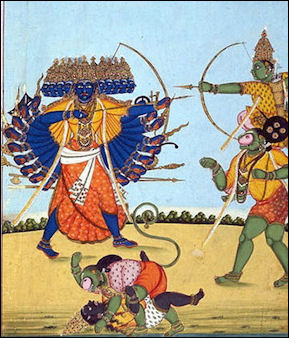
Rama and Hanuman fighting Ravana,
scene from the Ramayana The Hindu sacred texts are divided into Shruti (“What Is Heard”) and Smriti (“What Is Remembered”). The Sruti — which includes the Vedas and Upanishads — are considered to be divinely inspired while the Smriti — which includes the Mahabharata (including the Bhagavad Gita) and Ramayana — are derived from great sages. Some sources include a third category: nyaya (meaning 'logic'). Hindu Shruti-Smriti classifications are based on origin not on the mode of transmission. Therefore, shruti implies something heard directly from the Gods by the sages while smriti refers to what was written down and remembered. Shruti is considered more authoritative than smriti because the former is believed to have been obtained directly from God by the spiritual experiences of vedic seers and has no interpretations. Shruti primarily refers to the Vedas,
The Hindu epics and the Puranas are the most prominent of the Smritis ("remembered texts"). The Mahabharata and the Ramayana are the two epics. The Bhagavad Gita, which is an integral part of the Mahabharata, is one of the most popular sacred texts of Hinduism. The Puranas were composed starting from around 300 A.D. and contain extensive mythologies. They are central to the distribution of common themes of Hinduism through vivid narratives. The Ramayana was first written by Valmiki while Mahabharata was written by Sage Vyasa. Vyasa also wrote the eighteen puranas and eighteen sub-puranas. The puranas generally emphasize valued Hindu morals and are often stories about Hindu deities fighting to uphold these morals. There are also Kaavyas which are based on stories derived from the puranas. Among these, the Raghuvamsa, Meghaduta and Shakuntala are the most well known.
The Agamas are a collection of Tantric literature and scriptures from various Hindu schools. The term 'Agama' means tradition or 'that which has come down'. The Agama texts cover topics such as philosophical doctrines, cosmology, epistemology, four types of yoga, meditation practices, mantras, deity worship, ways to attain sixfold desires and temple construction. [Source: Wikipedia]
There are also Prakarana Granthas which are considered to be primers or an introduction for spiritual studies. Among them are Atma Bodha and Bhaja Govindam [also known as Moha Mudhgara]. There are also stotras and bhajans (devotional songs and hymns). Among the most famous stotras are Sahasranamams (1008 names of each deity).
Six Systems of Indian Philosophy
There are six systems of Indian philosophy (astika schools or ShhaDarshana) who recognize the authority of the Vedas. They are: 1) Jaimini's Purva Mimansa, 2) Patanjali's Yoga, 3) Gautama's Nyaya (Buddhism), 4) Kanada's Vaisheshika, 5) Vyasa's Vedanta (Uttar Mimansa) and 6) Kapila's Sankhya. All the six systems are written in aphorisms (sutras). Though each sutra is just a few lines, huge commentaries have been written on each of them. Besides all the philosophy which expound on the cosmic attributes of the Divine, there are epics (Itihaasa-s) and stories (Puranas) written which bring into light the human attributes of the Divine.
The Yoga Sutras is a classical text for the Hindu Yoga tradition. It regained popularity in the 20th century. Since the 19th century, Indian modernists have reasserted the 'Aryan origins' of Hinduism. They aim to 'purify' Hinduism from its Tantric elements and elevate the Vedic elements. Hindu modernists, such as Vivekananda, view the Vedas as the laws of the spiritual world. These laws would still exist even if they were not revealed to the sages. [Source: Wikipedia]
Tantra is a set of religious scriptures that give prominence to the female energy of the deity. This energy is personified in both gentle and fierce forms. In the Tantric tradition, Radha, Parvati, Durga, and Kali are worshipped symbolically and in their personified forms. The Agamas in Tantra refer to authoritative scriptures or the teachings of Shiva to Shakti, while Nigamas refer to the Vedas and the teachings of Shakti to Shiva. In Agamic schools of Hinduism, the Vedic literature and the Agamas are equally authoritative.
Vedas
The Vedas, which means "knowledge" in Sanskrit, are Hinduism's oldest sacred scriptures.They are believed to be the world's most ancient religious texts. Defining truth for Hindus, they comprise tens of thousands of hymns that describe the worship of nature, performance of rituals and the mysteries of existence.
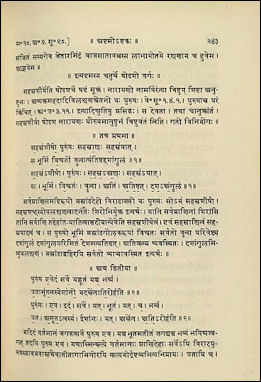
Rig Veda page Hinduism in India traces its source to the Vedas, ancient hymns composed and recited in Punjab as early as 1500 B.C. Three main collections of the Vedas — the Rig, Sama, and Yajur — consist of chants that were originally recited by priests while offering plant and animal sacrifices in sacred fires. A fourth collection, the Atharva Veda, contains a number of formulas for requirements as varied as medical cures and love magic. The majority of modern Hindus revere these hymns as sacred sounds passed down to humanity from the greatest antiquity and as the source of Hindu tradition.[Source: Library of Congress *]
The Vedas got their present form between 1200-200 B.C. and were introduced to India by the Aryans. Hindus believe that the texts were received by scholars direct from God and passed on to the next generations by word of mouth. Vedic texts are sometimes called shruti, which means hearing. For hundreds, maybe even thousands of years, the texts were passed on orally. [Source: BBC |::|]
The sacred texts known as the “Vedas", or “Vedic" Verses, were written in Sanskrit between 1500 to 900 B.C. They are associated with the founding of Hinduism and consist of four texts: 1) the “Rig Veda” , a collection of 1,028 hymns and prayers; 2) the “Soma Veda” , a collection of verses taken mostly from the “Rig Veda” that have been rearranged for chanting at sacrifices; 3) the “Yajur Veda” , prose with instructions on how the prose is to be used in ceremonies; and 4) the “Antharva Veda” , comprised primarily of formulas and spells The religion described in the Vedas is more Aryan religion than Hinduism because so much emphasis is put on sacrifices. Many important gods in the Vedas have all but been forgotten while gods like Shiva and Vishnu that are minor gods in the Vedas are now major figures in Hinduism. The Vedas seems to have been written by people who lived in the Punjab and had little knowledge of people in the Ganges Plain and elsewhere in India. Few people read the Vedic verses today. They were largely passed down orally over the century until an Englishmen wrote them down in the 18th century. Vedic (pronounced VAY-dick) is Sanskrit for knowledge.
See Separate Articles: SELECTIONS, PASSAGES AND QUOTES FROM THE VEDAS factsanddetails.com ; VEDIC PERIOD (1500–500 B.C.): ARYANS, EARLY HINDUISM, LIFE AND GOVERNMENT factsanddetails.com ; ORIGINS AND EARLY HISTORY OF HINDUISM factsanddetails.com
Content of Vedas
The Vedas describe pantheon of gods, supported by the belief that God is everywhere in everything. Gods are referred to as “devas” , derived from the old Sanskrit “div” , meaning brightness. They are not beings arranged into a hierarchy or order of nature, but rather sources of blinding light that leave anyone who comes in contact with them awestruck and spellbound.
Early descriptions of the caste system are found in the Vedas, which describe Aryan society as being divided into the four major castes: the Brahmins (priestly caste); Kshatriyas (warrior caste), the Vaisyas (farmer caste); and Sudras (laborers). The distinction is made primarily to define Brahmas as priests and ceremonial leaders.

Vivaha sukta, Rigveda 10:85, 16-22, dated to 1500-1200 BC, in Sanskirt from the Devanagari manuscript
The Vedas are filled with conversations and stories with moral or spiritual messages. One conversation between a father and son goes:
“"Fetch me a fruit of the banyan tree."
"Here is one, sir."
"Break it."
"I have broken it, sir."
"What do you see?"
"Very tiny seeds, sir."
"Break one."
"I have broken it, sir."
"Now what do you see?"
"Nothing sir."
"My son," the father said, "what you do not perceive is essence, and in that essence the mighty banyan tree exists. Believe me, my son, in that essence is the self of all that is. That is the True, that is the Self. And you are that Self, Sveraketu!"”
The Vedas are made up of four compositions, and each veda in turn has four parts which are arranged chronologically: 1) The Samhitas are the most ancient part of the Vedas, consisting of hymns of praise to God. 2) The Brahmanas are rituals and prayers to guide the priests in their duties;. 3) The Aranyakas concern worship and meditation. 4) The Upanishads consist of the mystical and philosophical teachings of Hinduism. [Source: BBC |::|]
The Samhitas: 1) Rig-Veda Samhita (c. 1200 B.C.) is the oldest of the four vedas and consists of 1028 hymns praising the ancient gods. 2) Yajur-Veda Samhita is used as a handbook by priests performing the vedic sacrifices. 3) Sama-Veda Samhita consists of chants and tunes for singing at the sacrifices. 4) Atharva-Veda Samhita (c. 900 B.C.) preserves many traditions which pre-date the Aryan influence and consists of spells, charms and magical formulae. |::|
Dating the Vedas
There is a some debate surrounding the exact history and date of the Vedas. One source above says they were composed between 1500 B.C. and 600 B.C. Another says they got their present form between 1200-200 B.C. Many say they dates back to 1900 B.C., or even 4000 B.C. They were first translated into European languages in the late 18th and early 19th centuries. At this time, it was widely believed to their makers could not have made something older than classic European texts. That idea persisted for some time the West. Today, some India historians are trying push the origin of The Vedas back to the beginning of dawn of human civilization between 4000 and 3000 B.C.
Dr. Michael Witzel, Wales Professor of Sanskrit, Harvard University, said the Rig Veda is no older than 1400 B.C., based on the references to metals (bronze, and no iron), horses, and chariots. He maintains that there was no evidence to support earlier dates. He also said that Vedic Sanskrit was imported to the region, as shown by the similarity with many other languages, although there was a local substratum of language and customs that were retained in the Vedic times. [Source: Science Center at Harvard University, On 14 March 2010, lokvani.com]

Devi sukta, Rigveda10, 125 5-6, dated to 1500-1200 BC, in Sanskrit from the from the Devanagari manuscript, AD 1735
According to the Aryan invasion theory, first proposed by the British archaeologist Mortimer Wheeler around the early part of the twentieth century, the Vedas were not composed in India. They were composed by members of so-called Aryans tribes who invaded India from the Northwest, destroyed the old civilisation in the Indus Valley. Hindu nationalists promote the idea, saying the Indus Valley was inhabited by Dravidians who were driven to the south of India by the Aryans. and other parts. The Indus Valley civilization emerged around 3300 B.C. And declined around 1500 B.C. or earlier. There are Hindu nationalist overtones to the Dravidian-Aryan aspect of this theory and no archaeological evidence to back it up. Many Indian historians argue that the Indus Valley civilisation declined by 1800 BC and the Aryans appeared in north-west India around 1500 BC. Using philological evidence, the overlap between Vedic Sanskrit, old Persian and ancient European languages, they have argued since the 19th century that the Rig Vedic Aryans came from outside. Recently scholars at the University of Delhi and elsewhere, to push back the commonly accepted date of the Vedas through astronomical calculations. [Source: Vikas Pathak, The Hindu, September 18, 2015 ^^^]
Ramesh Bhardwaj, head of the Sanskrit Department at Delhi University, said: “Many scholars have used archaeology to date the Vedas, and this does not take them before 3000 BC. But there are other dating tools that have been ignored or forgotten. There are instances where Vedic literature offers the positions of stars and constellations at the moment it was composed. This can be calculated back mathematically to figure out the date when the positions actually corresponded to the description.” Mr. Bhardwaj says this can offer the latest possible date of the text, be it “5000 or 10,000 years back”. Historian D.N. Jha told The Hindu: “People have come up with dates ranging from 1100 BC to 4000 BC from astronomical calculations. This shows that the evidence itself is dubious.” He added that for the Rig Veda, it was difficult to say whether what was being seen as a constellation was indeed a description of one.” ^^^
Vedas and Polytheism
The vast majority of Vedic hymns are addressed to a pantheon of deities who are attracted, generated, and nourished by the offerings into the sacred flames and the precisely chanted mantras (mystical formulas of invocation) based on the hymns. Each of these deities may appear to be the supreme god in his or her own hymns, but some gods stand out as most significant. Indra, god of the firmament and lord of the weather, is the supreme deity of the Vedas. Indra also is a god of war who, accompanied by a host of storm gods, uses thunderbolts as weapons to slay the serpent demon Vritra (the name means storm cloud), thus releasing the rains for the earth. Agni, the god of fire, accepts the sacrificial offerings and transmits them to all the gods. Varuna passes judgment, lays down the law, and protects the cosmic order. Yama, the god of death, sends earthly dwellers signs of old age, sickness, and approaching mortality as exhortations to lead a moral life. Surya is the sun god, Chandra the moon god, Vayu the wind god, and Usha the dawn goddess. *
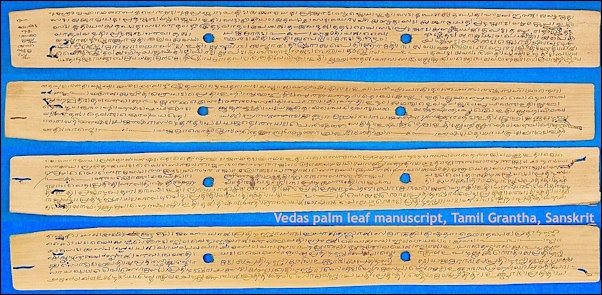
Vedas on palm leaf manuscripts, Tamil Grantha scriptm Sanskrit, from Tamil Nadu
Some of the later hymns of the Rig Veda contain speculations that form the basis for much of Indian religious and philosophical thought. From one perspective, the universe originates through the evolution of an impersonal force manifested as male and female principles. Other hymns describe a personal creator, Prajapati, the Lord of creatures, from whom came the heavens and the earth and all the other gods. One hymn describes the universe as emerging from the sacrifice of a cosmic man (purusha ) who was the source of all things but who was in turn offered into the fire by gods. Within the Vedic accounts of the origin of things, there is a tension between visions of the highest reality as an impersonal force, or as a creator god, or as a group of gods with different jobs to do in the universe. Much of Hinduism tends to accept all these visions simultaneously, claiming that they are all valid as different facets of a single truth, or ranks them as explanations with different levels of sophistication. It is possible, however, to follow only one of these explanations, such as believing in a single personal god while rejecting all others, and still claim to be following the Vedas. In sum, Hinduism does not exist as a single belief system with one textual explanation of the origin of the universe or the nature of God, and a wide range of philosophies and practices can trace their beginnings somewhere in the hymns of the Vedas. *
By the sixth century B.C., the Vedic gods were in decline among the people, and few people care much for Indra, Agni, or Varuna in contemporary India. These gods might appear as background characters in myths and stories about more important deities, such as Shiva or Vishnu; in some Hindu temples, there also are small statues of Vedic deities. Sacrificial fire, which once accompanied major political activities, such as the crowning of kings or the conquest of territory, still forms the heart of household rituals for many Hindus, and some Brahman families pass down the skill of memorizing the hymns and make a living as professional reciters of the Vedas. One of the main legacies of Brahmanical sacrifice, seen even among traditions that later denied its usefulness, was a concentration on precise ritual actions and a belief in sacred sound as a powerful tool for manifesting the sacred in daily life. *
Upanishads
The “Upanishads” or “Seances” are commentaries on the Vedas. Written between 800 and 600 B.C and comprised of a series of discourses and dialogues by "men whose hair had grown white and who had seen their sons' sons," they provide a theoretical basis for Hindu cosmology and teach that liberation can be obtained by doing tasks that are "difficult and painful as walking the razor's edge" and were written when Hinduism was going through a period of deep introspection on "the infinite depth of the Soul" and "brooding on the meaning of existence." The poet W.B. Yeats translated the Upanishads.
The Upanishads were so called because they were taught to those who sat down beside their teachers. (upa=near, ni=down, shad=sit). These texts developed from the Vedic tradition, but largely reshaped Hinduism by providing believers with philosophical knowledge. The major Upanishads were largely composed between 800-200 B.C. and are partly prose, partly verse. Later Upanishads continued to be composed right down to the 16th century. Originally they were in oral form. [Source: BBC |::|]

Chandogya Upanishad on a plam leaf strip
The early Upanishads are concerned with understanding the sacrificial rites. Central to the Upanishads is the concept of brahman; the sacred power which informs reality. Whilst the priests (brahmins) had previously been the ones who, through ritual and sacrifice, had restricted access to the divine, now the knowledge of the universe was open to those of the high and middle castes willing to learn from a teacher. |::|
Kalpana Srivastava wrote in the Industrial Psychiatry Journal: “Upanishads are store house of psychological material. The nature of mind and its functions and different psychological phenomena–normal, abnormal, pathological, paranormal, and spiritual–are explained in Vedas and Upanishadas. The core themes, according to the ancient philosophical tradition are centered around self, soul, human nature, human existence, and human experience.” [Source: Kalpana Srivastava, Industrial Psychiatry Journal, July-December 2012 ~]
Contents of the Upanishads
“There are 12 major Upanishads, which fall into three groups, ‘each standing for definite stage of thought development connected with the two Ultimates of reality’ Brhadaranyka, Chandogya, Is’a, Kena, Mandukya, Aitereya, Taittiriya, and Kausitiki are the ones, which come under the early Upanishadic period. Mundaka and Katha fall into the mid-Upanishadic period. Prasna and Svetasvatara belong to the later Upanishadic period. Upanishads Mandukya and Taittiriya, have significance in contemporary psychology in the context of studies on consciousness and personality. ~
The ancient Indian model of “Personality”, given in the Upanishads, consists of the ‘five’ sheaths. They are ‘Annamaya’ (food sheath), ‘Pranamaya’ (vital air sheath), ‘Manomaya’ (mental sheath), ‘Vijnanamaya’ (intellectual sheath), and ‘Anandamaya’ (bliss sheath). ‘Annamaya’; a segment of human system is nourished by ‘anna’, that is, food. ‘Pranamaya’ is that segment which is nourished by ‘prana’, that is, ‘bioenergy’. ‘Manomaya’ is the segment nourished by ‘education’. ‘Vijnanamaya’ is nourished by ‘ego’ and ‘Anandamaya’ is the segment nourished by ‘emotions’.
The Vedas and the Upanishads and two other texts — the “Sambitas” and the “Brahmanas” “and a few “sutras” are collectively known as the “Shruti” , which means “that which is heard.” They are considered the eternal truth and have traditionally been handed down orally. The “Aranyakas” (“Forest Books”) is a later philosophical work associated with the “Upanishads” . It offers guidance in leading a holy life and understanding rituals. The “Laws of Manu” were written around 250 B.C. These texts established Hindu law based on a large number of wise sayings a and prohibitions in everyday life. The principals of the caste system were outlines in the Laws of Manu.
The “Puranas” (“Sacred Traditions”) are lengthy medieval texts that rehash old legends; deliver new ones; and clarify Hindu cosmology, theology and religious practices. There are separate puranas devoted to Shiva and Vishnu. Other texts that emerged in the medieval period are the “dharamasutras” (law books) and “bhashyas” (philosophical works). In these book are deeply spiritual and literary songs that are known and cherished by most Hindus. Around this time a wide number of texts began appearing in local languages.

Chandogya Upanishad on a palm leaf manuscript
Puranas
Vinay Lal, professor of history at UCLA wrote: “The Puranas are a class of literary texts, all written in Sanskrit verse, whose composition dates from the 4th century B.C. to about 1,000 A.D. The word "Purana" means "old", and generally they are considered as coming in the chronological aftermath of the epics, though sometimes the Mahabharata, which is generally classified as a work of itihas (history), is also referred to as a purana. Some scholars, such as van Buitenen, are inclined to view the Puranas as beginning around the time that the composition of the Mahabharata came to a close, that is about 300 A.D. Certainly, in its final form the Mahabharata shows puranic features, and the Harivamsa, which is an appendix to the Mahabharata where the life of Krishna or Hari is treated at some length, has sometimes been seen as a purana. [Source: Vinay Lal, professor of history, UCLA +++]
“The special subject of the puranas is the powers and works of the gods, and one ancient Sanskrit lexicographer, Amarasinha, writing in the fifth or sixth century A.D., defined a purana as having five characteristic topics, or pancalaksana: "(1) The creation of the universe; (2) Its destruction and renovation; (3) The genealogy of gods and patriarchs; (4) The reigns of the Manus, forming the periods called Manwantaras; (5) the history of the Solar and Lunar races of kings." No one purana can be described as exhibiting in fine (or even coarse) detail all five of these distinguishing traits, but sometimes the Vishnu Purana is thought to most closely resemble the traditional definition. Around the time when the puranas first began to be composed, the belief in particular deities had become established as one of the principal marks of the Hindu faith, and to some degree the puranas can be described as a form of sectarian literature. Some puranas exhibit devotion to Shiva; in others, the devotion to Vishnu predominates. +++
“There are eighteen major puranas, as well as a similar number of minor or subordinate puranas. One method of the classification of puranas deploys the traditional tripartite division of the gunas or qualities which tend toward purity (sattva), impurity or ignorance (tamas), and passion (rajas). Thus, there are those puranas where the quality of sattva is said to predominate, and these are six in number: Vishnu; Narada; Bhagavata; Garuda; Padma; and Varaha. According to another scheme of classification, these are also the puranas in which Vishnu appears as the Supreme Being. A second set of puranas, also six in number, are described as exhibiting qualities of ignorance or impurity (tamas), and in these Shiva is the God to whom devotion is rendered: Matsya; Kurma; Linga; Shiva; Skanda; and Agni. In the third set of six puranas, the quality of rajas or blind passion supposedly prevails: Brahma; Bramanda; Brahmavaivarta; Markandeya; Bhavishya; and Vamana. The list of eighteen is sometimes enlarged to twenty, to include the Vayu Purana and the Harivamsa. Yet clearly this mode of classification, which shows every sign of sectarianism, is inadequate, since none of the puranas is devoted exclusively to either Vishnu or Shiva. +++

“Among these puranas, the Vishnu Purana and the Bhagavata Purana (also known as the Bhagavatam) are, with respect to their standing as works of devotional literature, preeminent; and the Bhagavata Purana is even the supreme work of Krishna devotional literature. Since each of the eighteen major puranas enumerates the other puranas, it is reasonable to surmise that all the puranas were revised at one point. Their length varies considerably: the Skanda has 80,000 couplets, while the Brahma and Vamana Puranas have 10,000 couplets each. +++
“Though all the Puranas have been translated into major Indian languages as well as English, only a few of them, principally the Vishnu Purana and the Bhagavatam, can safely be described as being widely known. Nonetheless, the stories told in the Puranas are part of the common currency, and in this respect the Puranas can rightfully be spoken of as the scriptures of popular Hinduism. It is the Puranas that British scholars had in mind when they mocked the literature of the Hindus as fanciful, hyperbolic, and absurd. Genealogies in which certain kings are said to rule for thousands of years, or conceptions of time where tens of thousands of years are said to be a mere instant, were not calculated to make the British regard the Puranas as a set of rational religious texts. However, it requires a very different imagination, as well as interpretive strategy, to read the Puranas. To suppose that Hindus truly believe in "330 million gods and goddesses" is to fail to understand the place of numbers in the Indian imagination, and the hermeneutic, interpretive, and creative work that numbers do. +++
“The Puranas are works that most eminently represent the deep mythic structuring of Indian civilization, and they are properly viewed as expanding upon, modifying, and transforming the orthodox Brahminism of the Vedas, principally by the introduction of the idea of bhakti or devotion. It is the Puranas which, it is no exaggeration to say, assisted in the transition from Brahminism to Hinduism, particularly a Hinduism that was more receptive to folk elements, popular forms of devotion and worship, and everyday arts, crafts, and sciences. The Puranas carry story about the gods who had become the objects of people’s devotion, as well as about the modes of worship of these gods; these gods are no longer Vedic gods, but the gods who form the Hindu trinity. Besides them, the Puranas speak of the battle between the devas and the asuras, and one can doubtless read the narratives as allegorical accounts of the struggle within each person between the forces of ‘light’ and the forces of ‘darkness’. The Puranas delineate the religious obligations by which each person is bound, and as such they are a guide to dharmic living. Though the Puranas are a vast repository of Hindu lore, religious practices — yoga, vows, puja, prayers, sacrifices — and everyday customs, they are not without a sense of humor and irony, and they complement the metaphysical austerity of the Upanishads, the magical and sacrificial lore of the Atharva Veda, and the sacerdotal orthodoxy of the Rig Veda.” ++++
Mahabharata, Ramayana and Bhagavad Gita
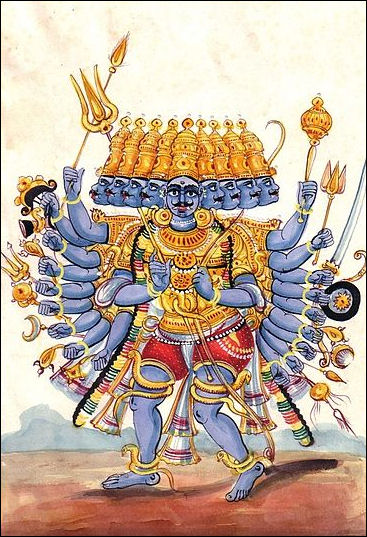
Ravana The Hindu epics and the Puranas are the most prominent of the Smritis ("remembered texts"). The Mahabharata and the Ramayana are the two epics. The Bhagavad Gita, which is an integral part of the Mahabharata, is one of the most popular sacred texts of Hinduism. [Source: Wikipedia]
According to the BBC: “Composed between 500 B.C. and 100 CE, the Mahabharata is an account of the wars of the house of Bharata. It is one of the most popular Hindu texts and is known as a smriti text (the remembered tradition). This is considered by some to be of less importance than shruti (the heard text, such as the Vedas). It has, nevertheless, an important place within the Hindu tradition. [Source: BBC |::|]
The Bhagavad Gita, or "Song of the Lord" is part of the sixth book of the Mahabharata, It takes the form of a dialogue between prince Arjuna and Krishna, his charioteer. Arjuna is a warrior, about to join his brothers in a war between two branches of a royal family which would involve killing many of his friends and relatives. He wants to withdraw from the battle but Krishna teaches him that he, Arjuna, must do his duty in accordance with his class and he argues that death does not destroy the soul. Krishna points out that knowledge, work and devotion are all paths to salvation and that the central value in life is that of loyalty to God. |::|
Composed in the same period, the Ramayana is one of India's best known tales. It tells the story of Prince Rama who was sent into exile in the forest with his wife, Sita, and his brother, Lakshamana. Sita was abducted by the evil demon Ravana but ultimately rescued by Prince Rama with the help of the Monkey God, Hanuman. The story is written in 24,000 couplets. The symbolism of the story has been widely interpreted but basically is the story of good overcoming evil. Many people have said that it is a story about dharma or duty. |::|
Steven M. Kossak and Edith W. Watts from The Metropolitan Museum of Art wrote: “Indian people have treasured, in particular, two great epics: the Ramayana (2nd century B.C.) and the famous epic poem, the Mahabharata (500–400 B.C.), both of which may be based on actual historical events. The Ramayana has been, and still is, a rich source for art.” [Source: Steven M. Kossak and Edith W. Watts, The Art of South, and Southeast Asia, The Metropolitan Museum of Art, New York]
The "Ramayana” and the “Mahabharata” are epics like the “Iliad or “ Jason and the Argonauts. Believed to have been written between 200 B.C. and A.D. 200, with some parts probably written earlier and some parts probably written later, they are comprised of myths and stories about romance and war, and are part of a collection of texts, known as “Shmriti” (“That Which has been Remembered”), which are regarded as being supportive of the “shruti”. Amid the adventure of Hindu gods and heroes are found laws and regulation regarding caste, eating, idolatry, sacred places, festivals and superstitions. There are also long didactic passages offering guidance on politics, morality, ethics and religion. Although the “Ramayana” and “Mahabharata” were written millennia ago they remain very much alive today. When a serial drama version of the “Ramayana” was shown on television in the late 1980s and early 1990s the whole country was quiet on Sunday morning as people tuned in. The sale of television sets soared. Those that could not afford new sets gathered around windows to watch episodes. In some places the buses stopped running so the drivers could tune in. The shows was also very popular in Pakistan. One of the most devastating bombing attacks in Karachi took place outside a television shop where people had gathered to watch the series.
See Separate Articles HINDU LITERATURE: RAMAYANA, MAHABHARTA AND BHAGAVAD GITA factsanddetails.com
Ramayana
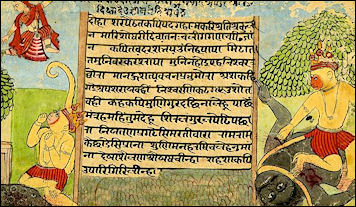
Hanuman slaying demons
on Ramayama manuscript Ramayana (Sanskrit for "The Romance of Rama" or “The Career of the Rama”) is a great epic poem that is 24,000 verses long. it consists of seven books and tells the story of Rama, or Ramachandra, the King of Ayodhya and the God of Truth, and his adventures. The work is attributed to the poet Valmiki although it was probably written by several authors and embellished over the centuries by others.
The Ramayana is a cornerstone of religion and literature not only in India but in other South Asian and Southeast Asian nations as well. It was originally written in Sanskrit but has been translated into numerous other languages. There are many variations. The Ramayana is somewhat reminiscent of the Odyssey in its organization and plot. The stories may be based on a real life king named Rama who helped spread Hindu and Aryan ideas throughout India. Hindu nationalists believe this and based their 1980s attack on mosque in Adoyda’said to have been built on the site of Rama’s birthplace — on this belief.
Simply reading or hearing the Ramayana is said to bring about good things. The last paragraph reads: “He that has no sons shall attain a son by reading even a single verse of Rama’s song. All sin is washed away from those who read or hear it read. He who recites the Ramayana should have rich gifts of cows and gold. Long shall he live who reads the Ramayana, and shall be honored, with sons and grandsons in this world and in Heaven.”
See Separate Articles RAMAYANA: IT'S HISTORY, STORY AND MESSAGES factsanddetails.com ; PASSAGE AND SELECTION FROM THE RAMAYANA: THE INAGURATION OF RAMA AS KING factsanddetails.com
Bhagavad Gita
The “Bhagavad Gita” ("Song of God") is an epic poem consisting of 701 Sanskrit couplets. Part of the “Mahabharata”, it blends theology and political science with a dramatic story of dynastic struggle. According to legend it was written by the sage Vyasa. It probably existed independently of the “Mahabharata” and was added and revised to its present form around the A.D. 2nd century. Today, it is the most widely read Hindu text.

Vyasa
The “Bhagavad Gita” is essentially a devotional poem set among the battles of the “Mahabharata” . It outlines rituals accessible to everyone. This contrasts with the rituals described in old Vedic texts, which involved sacrifices and elaborate rites that were only open to upper castes. Many customs and fetishes have evolved around the “Bhagavad Gita” . Some people wear a miniature copy of it around their neck for luck and to ward off evil.
The “Bhagavad Gita” begins at the battlefield of Kurukshetra, a popular pilgrimage place today. Arjuna is brooding over the upcoming clash because he has friends, relatives and teachers on the other side. Krishna advises him to pour himself into the battle and not worry about the consequences, telling the warrior that is the only way he can find knowledge, freedom and peace.
Much of the text is made of dialogues between Krishna and Arjuna with Krishna encouraging Arjuna to fight and overcome his reluctance not to fight. Krishna tells Arjuna that he must fight because he is a warrior by caste and it is his duty to fight, saying: “For there is more joy in doing one’s duty badly that in doing another’s well. It is a joy to die doing one’s duty, but doing another man’s duty brings dread.”
See Separate Articles MAHABHARATA AND BHAGAVAD GITA factsanddetails.com
Passages From the Bhagavad Gita
A famous dialogue between Krishna and Arjuna — one that has been described by the Library of Congress as "one of the great jewels of world religious literature” — occurs after Krishna changes from the human form into the "universal form" before battle to inspire Arjuna to defeat an enemy which has Krishna said are "already put to death by my arrangement."
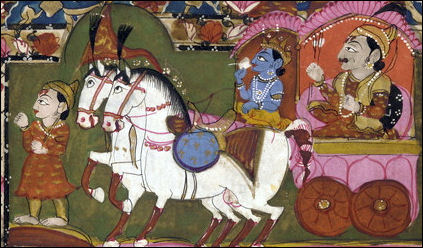
Krishna and Arjuna on the chariot Mahabharata “Do the work that you have to do.
For work is better than inaction.
You cannot even keep your body alive
if you are wholly inactive...
If I did always work
Unwearying...
men would follow my ways.
The worlds would perish if I did not
work?
I should bring back chaos.
and all beings would suffer...
Cast all you acts upon me.
With your mind in the highest Soul.
Have done with craving and selfhood.
Throw off your terror, and fight!”
Concepts in the Bhagavad Gita
The central premise of the “Bhagavad Gita” is that all Hindus (or even all people), even Untouchables, who obey the rules of their caste and follow the teachings of god will be reincarnated in successfully higher castes and eventfully end up in heaven. Connected with this is the idea that all actions should be guided by dharma, the external divine law that says people should fulfill their duty and let God decide the consequences of their actions. The “Bhagavad Gita” also address the immortality of the soul in a universals sense and teaches that God can take human form to relay his message.

Krishna and Arjuna from the Gita
Unlike Buddhism, which encourages its followers to withdraw from the world, the “Bhagavad Gita” encourages people to involve themselves in the world with a detached ego. Arjura learns that: 1) he is not limited to his physical form; 2) human consciousness flows through the entire universe; and 3) nothing in the world really matters. With these realizations Arjuna is freed of doubt and delusion and can realize his Higher Self and find fulfillment.
The “Bhagavad Gita” talks about three ways of approaching the world: 1) through the mind; 2) through emotions; and 3) through actions. Those are tied with three yogas, or methods of union with the Higher Self: 1) duty, 2) insight and 3) devotion.
There are three main obstacles, or “gunas” , that hinder development: 1) “Sattva”, being too attached to happiness, purity and righteousness; 2) “Rajas” , attachment to passion and activity; and 3) “Tamas”, attachment laziness and ignorance. Chapter V, 12 of the “Bhagavad Gita” reads:
“The disciplined man, having relinquished the fruit of action.
Attains perfect peace.
The undisciplined man, impelled by desire.
Is attached to the fruit of fruit and is bound.”
Image Sources: Wikimedia Commons
Text Sources: Internet Indian History Sourcebook sourcebooks.fordham.edu “World Religions” edited by Geoffrey Parrinder (Facts on File Publications, New York); “Encyclopedia of the World’s Religions” edited by R.C. Zaehner (Barnes & Noble Books, 1959); “Encyclopedia of the World Cultures: Volume 3 South Asia “ edited by David Levinson (G.K. Hall & Company, New York, 1994); National Geographic, the New York Times, Washington Post, Los Angeles Times, Smithsonian magazine, Times of London, The New Yorker, Time, Newsweek, Reuters, AP, AFP, Lonely Planet Guides, Compton’s Encyclopedia and various books and other publications.
Last updated December 2023
